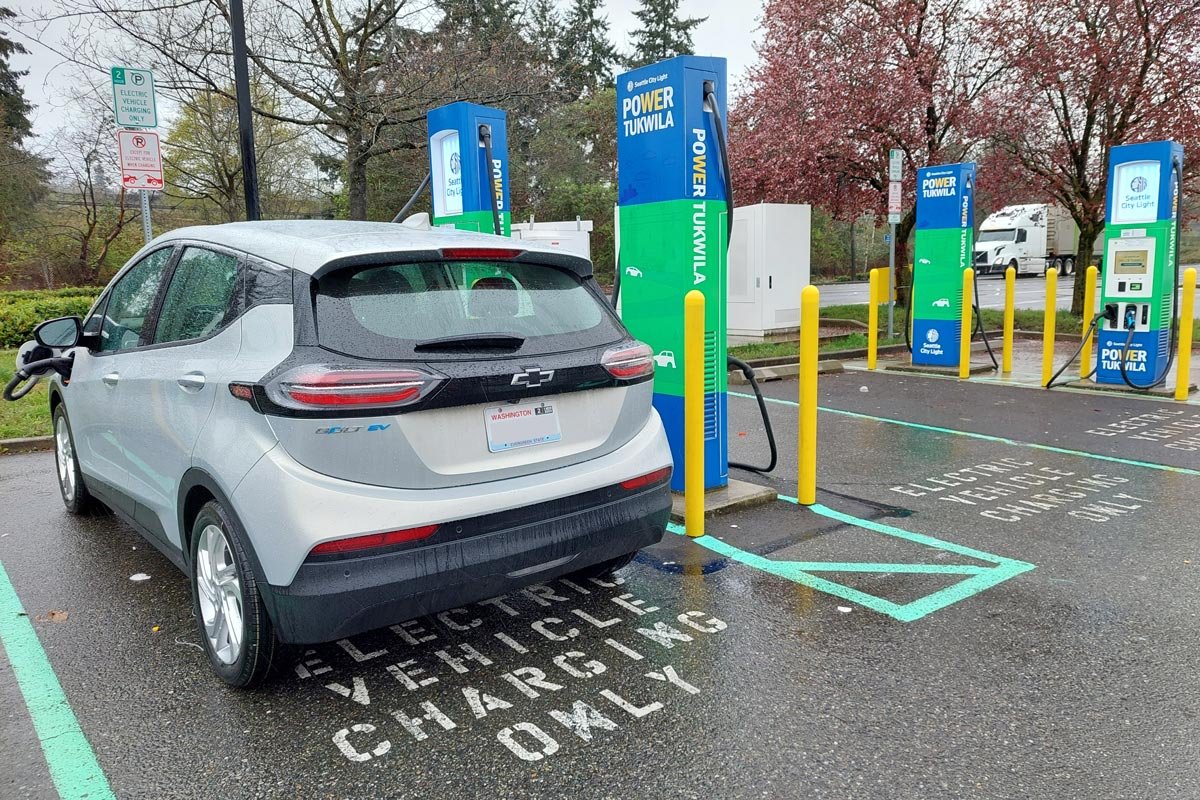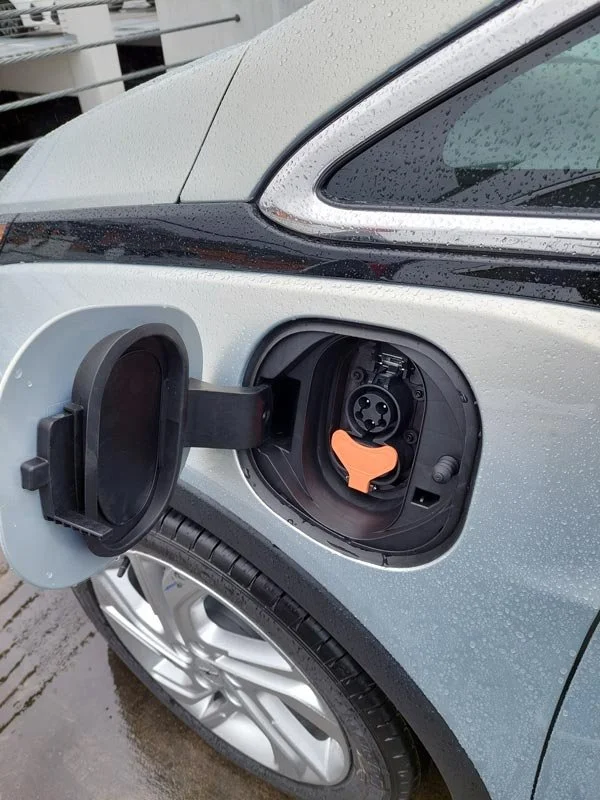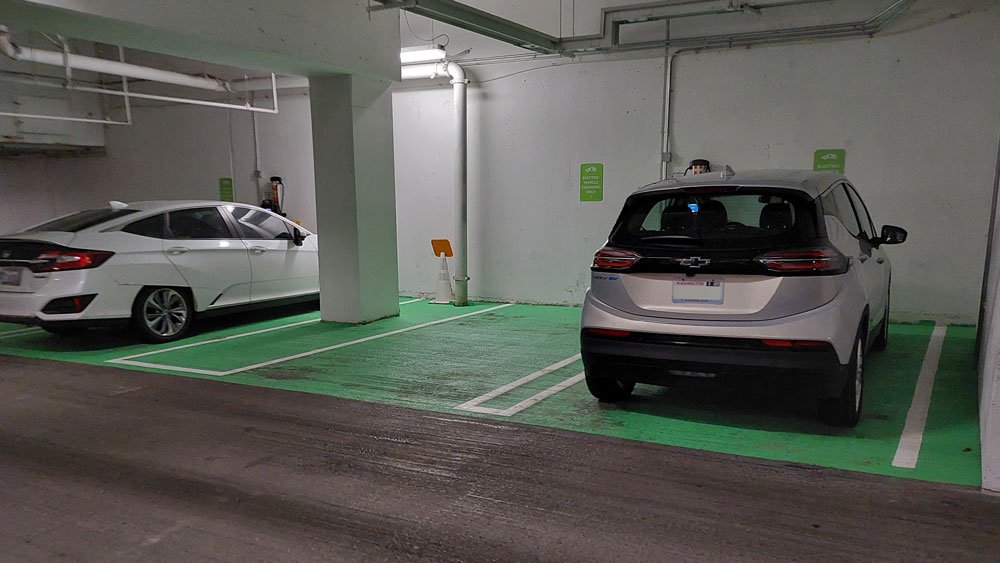Rented an electric vehicle (EV) at the airport; was it worth it?
The rented 2023 Chevrolet Bolt EV connected to a Level 3 DC Fast Charger.
Image: The Window Flyer
Electric vehicles are quickly gaining in popularity. It is projected that by 2030, roughly 1 in 3 new car sales in the United States will be an EV. The rise in electric vehicles might have you interested in driving one in the near future.
If you’re curious about what it’s like to drive an EV, maybe want to try an EV before buying one, or if you’re just looking for a more eco-friendly, environmentally-sustainable way to travel while visiting other cities, renting an EV is a great way to accomplish that.
You may be wondering where you might be able to rent an electric vehicle. Renting an EV at the airport is a good option since rental car agencies typically have their largest selection and availability of rental cars located at any given city’s airport.
Many rental agencies have added electric vehicles to their lineups in recent years, including Hertz, Enterprise, Thrifty, Dollar, National, Avis, etc. Vehicle selections and availability will likely vary by city and airport until EVs reach mass adoption. But chances are, rental car companies at an airport in a major city will have some electric vehicles on-hand, ranging from Chevy Bolts to Teslas.
I recently rented an electric vehicle at Seattle Tacoma International Airport for a weekend trip around the Seattle area. Here’s my review of how it went, my thoughts about the experience of renting an EV, and who it might be best-suited for.
Key takeaways about renting an electric vehicle (EV)
Airports have the widest selection of rental cars
Renting an EV was easy and the process was no different than renting a regular gasoline-powered car
Charging the car was cheaper than buying gas
Charging the rented EV during the rental was relatively simple, but charging it to virtually 100% full at the end of the rental was time consuming and took some logistical planning
Renting an EV is probably best-suited for those who will be driving around the city, making stops at places throughout the day. Long road trips in a rented EV will require time for charging, but charging time can be optimized with careful route planning.
Finding an electric vehicle to rent
Unlike airlines, I generally don’t have preference toward any one rental car company, and renting cars is primarily a cost-driven decision for me. Therefore, I typically use an online travel agency (OTA), such as Expedia, to rent cars as it allows me to compare rates from different rental car companies and ensure I get the best price.
Another advantage of using an OTA is the opportunity to earn loyalty points with that agency, which can be pooled with points from other bookings made with the agency, such as airline tickets, hotel stays, and cruises. OTAs like Expedia can also save you money if you book a bundled package that combines airline tickets, rental car, and hotel stay under a single purchase.
For this trip, I just did a standalone, two-day rental car booking from Expedia.
My experience booking an EV with Expedia was easy. Their search engine clearly identified which cars were electric vehicle under the car’s description. A quick way to find the EVs was to do a text search for “electric” in the web browser.
To my surprise, the price of renting an electric car was on-par with comparable cars with internal combustion engine (ICE) running on gasoline. For example, in the screenshot below, an electric vehicle is about the same price to rent as a typical sedan.
Picking up the rental electric vehicle
Seattle Airport’s Rental Car Facility
Image: JW_PNW / Shutterstock.com
On the day of the rental, I took a quick shuttle ride from Sea-Tac’s main terminal to the airport’s consolidated Rental Car Facility. There are a number of different ways to get to SEA’s Rental Car Facility, including transit, rideshare, or walking, but the free shuttle is the most direct way.
Checking in and getting the car was no different than any other car rental. I walked up Thrifty’s counter, provided them with the usual required driver’s information, inserted my credit card, and my car rental was processed.
Picking up the 2023 Chevy Bolt EV was the same as picking up any other rental car - it was waiting in a numbered stall along with other vehicles.
Image: The Window Flyer
Grabbing the car after check-in was no different than renting any other car – the car was parked in a numbered stall next to all sorts of other vehicles – gasoline powered, hybrids, pickup trucks, other EVs, etc. There was no charging cable to unplug either; the car came fully-charged.
I was assigned a 2023 Chevy Bolt EV, which comes with an EPA-estimated 259-mile driving range; plenty of charge to get around Seattle for the weekend, as well as venture up into the Cascades for an afternoon trip.
How full does the battery need to be when returning a rented electric vehicle (EV)?
During check-in, I verbally inquired about Thrifty’s policies regarding how full the car’s battery should be when I brought the car back. Similar to a gasoline-powered vehicle, they mentioned my EV should be brought back with a full battery (more on that later) minus a few miles to account for driving distance from the charging station. Alternatively, I had the option to bring it back with a minimum 10% State of Charge (SOC) in exchange for a $35 flat-rate charging fee.
It turns out after checking the written policy retroactively, the check-in counter representative didn’t quite get their policy right. But that’s totally forgivable and understandable since EVs are still relatively new and we’re all learning. Per their policy, only under certain conditions would the EV need to be returned with a full battery. With my arrangement, I technically only needed to return the vehicle with a 70% charge. You can read more about that in my closing thoughts.
But with that said, my misguided experience of charging the battery to full before returning the car did provide some valuable insights with regards to what it actually takes to charge an EV to a full state of charge in the event someone is ever required to do so.
Driving a rental electric vehicle
The Chevy Bolt’s driver information display was pretty informative, showing power consumption and regeneration rates, as well as projected driving range and battery level.
Image: The Window Flyer
As one might expect, driving an EV was not really any different than driving a traditional gasoline-powered vehicle. Plenty of acceleration power for a typical driver.
The only nuance was driving with the Bolt EV’s optional one-pedal driving mode where the gas pedal is used to control both the acceleration and braking of the vehicle, depending on how much pressure is applied to the pedal. Being my first time driving a car with a one-pedal driving feature, it took a couple miles to get used to, but was pretty easy to get the hang of. Throughout the rental I switched between one-pedal and normal, two-pedal drive modes.
Where to charge a rented electric vehicle
The 2023 Chevrolet Bolt EV uses a standard J1772 connector for Level 1 and 2 charging, with an additional CCS1 combination port for Level 3 Fast Charging
Image: The Window Flyer
Renting an electric vehicle created some interesting considerations when it came to charging, mostly the time commitment for a final, full charge before returning the car.
As mentioned above, while it turns out (due to a miscommunication with the counter representative) that under my specific rental contract arrangement, I didn’t actually need to fill the battery to full, the process of getting the car battery to 100% gives some valuable insights for anyone looking to rent an EV.
This is valuable info for not only someone who may be contractually-obligated to do a full fill-up, but also those looking to use an EV for a long road trip.
Using Public Chargers
Charging for a couple hours at a public charging station in the hotel parking garage.
Image: The Window Flyer
Renting an EV meant being forced to use public charging stations to charge the car since the only truly-private plug is the one at your house. Many public chargers accepted contactless credit cards for one-time payments, but some required me to sign up for the charger’s network membership. Public charging station locations could easily found using various online resources including Google Maps, PlugShare, ChargePoint’s charging map, etc.
If you’re thinking about renting an EV in the future, it is important to understand that most public chargers are of the slower-charging Level 2 AC variant. These are typically the ones you have seen popping up at your local bank, apartment building, or grocery store’s parking lot, which are roughly the size of a small ATM or parking payment kiosk.
While Level 2 chargers are plentiful in cities, they usually are only capable of adding about 25 miles of driving range per hour of charging. In other words, to fully-charge a typical EV with a near-empty battery will take about 4 to 12 hours on a Level 2 charger, depending on the battery’s capacity. This might be okay if you’re charging the car overnight at a hotel, but certainly poses a problem if your vacation involves a long road trip with the need to charge along the way.
Most public charging stations are Level 2 AC chargers, which only add about 25 miles of driving distance per hour of charging. The 2023 Chevy Bolt EV showed a projection for charging from 50% to 100% to take about 6 hours.
Image: The Window Flyer
In my opinion, the intended use for public Level 2 AC chargers is to put an electric vehicle on the charger for an hour here and there while you’re making stops in the city throughout the day, similar to how we plug our smartphones in for a little bit at a time to “top off” the battery.
On the flipside, there are Level 3 DC chargers. These are the rapid chargers everyone raves about, which can charge your car in 1 to 2 hours. This can solve the time concern if taking a rented EV on a long road trip. However, be aware that due to the large equipment required to power these chargers, Level 3 chargers are more sparsely located and may require you to drive some distance to find. It’s possible that smaller towns and remote areas may not have coverage with Level 3 chargers.
Depending on your trip profile (i.e. where you’re taking the rental car, how quickly you need it to charge, etc.) researching the availability of Level 3 DC rapid chargers is something you’ll want to do before renting an electric vehicle. Most online mapping tools allow you to isolate chargers based on type.
Electric vehicle charging stations were generally free and available without any wait time. Adjacent to the rented Chevy Bolt was a Honda Civic plug-in hybrid.
Image: The Window Flyer
Home Outlet Charging
The car contained a portable charging kit in the trunk, which is useful for charging if you’ll be staying at a residential property during your trip.
Image: The Window Flyer
I personally didn’t use this, but was pleased to find that the rented Chevy Bolt EV included portable charging equipment in the trunk, which allows the car to be plugged into a standard 120V or 240V receptacle. This is great if you’re renting an electric vehicle and planning to charge it at a friend or relative’s house, or at a vacation rental during your travels. Whether all rental car companies provide portable charging equipment with the car or not is a question you should ask when renting an EV.
How much cost and time does it take to charge an EV in public?
Charging Cost
I plugged-in the rental EV a few times over the weekend. Most instances were partial charges on a Level 2 AC charger while making stops for lunch and dinner, at the hotel in the morning before checking out, etc. to keep the battery around the 50% to 70% charge range. I then finished up charging the vehicle on a Level 3 DC rapid charger to fill up the battery to 100% before returning the car back at the airport.
The overall cost of charging during my trip turned out to be cheaper than buying gas. Through my four charging sessions, I only spent a combined $9.96 to charge it. Charging fees varied by station – some chargers were priced by the kilowatt hour, while others simply had a time-based rate. My average cost worked out to about $0.24/kWh, which covered 150 miles of driving and 41 kWh of energy usage.
For comparison purposes, if I had rented a 35 mpg gas-powered car instead, and gas was $3.60/gallon, my fuel cost would have been $15-$16.
Therefore, the cost to “fuel” the car with electricity was about 33% less than gas. Home-charging (for EV owners) would be even cheaper, but the average rates for public-charging a rented EV weren’t bad in my opinion.
Charging rates varied by charger, but the one pictured here used a time-based rate of only $1 per hour. With 11.6 kWh received during the couple hours parked, the cost was just $0.17 per kilowatt hour.
Image: The Window Flyer
Charging Time
As far as charging time required, this is where the value proposition of renting an EV may fall flat, depending on your trip profile.
If you’re just driving around the city where chargers are abundant and you’re charging the car while you engage in other activities, you won’t really lose any time. However, if you’re doing a long road trip and need to “wait” for the car to charge to a sufficient level before getting back on the road, then renting an EV may not be the right choice.
The final charge to bring the batter level to 100% was performed at a Level 3 DC Fast Charger near the airport.
Image: The Window Flyer
I spent a combined five and a half hours over the weekend to charge the car. Most of that was time-neutral since I was engaging in activities in the city (grabbing lunch, dinner, waiting in the hotel, etc.) while charging. However, doing a final charge-up to fill the battery to 100% before returning the car was where I took the biggest time penalty for a couple reasons.
First, similar to finding a gas station near the airport for a rented gasoline car, you also need to charge an EV near the airport. Since airports are usually located in the suburbs or away from the city, charging stations near the airport are located in rather un-interesting locations, so you’ll pretty much stuck with the car with not much else to do while waiting for the charging to be complete.
The Level 3 DC rapid CCS charger I used was about 3 miles from Sea-Tac Airport and located in a small suburban strip mall. There was a Starbucks on the other side of the parking lot, but I opted to spend my time in the car.
Secondly, filling up the battery to full also posed a time challenge because EV batteries have a charging curve that slows the rate of charge as a battery approaches a full state of charge. Similar to the rapid charging feature on your smartphone, charging to 50% moves pretty quickly, but the speed begins to taper off after that in order to protect the lithium ion battery from damage.
For my rented Chevy Bolt EV, the Level 3 DC rapid charger got the car to 80% pretty quickly, but it took an additional hour move from 80% to 100%. Overall, my final charge took about 90 minutes.
Connecting to a Level 3 DC Fast Charger increased the charging speed, but most EVs slow the rate of charging once the battery gets past a certain threshold in order to prevent damage from occuring.
Image: The Window Flyer
Returning a rented EV at the airport
Returning the electric vehicle was a breeze and no different than returning any other vehicle. There’s no special lane, or any charger you need to plug it into.
Like an ordinary airport rental car return process, I just followed the signs for return, pulled the car up to the designated drop point, turned the car off, left the keys in the vehicle, and then headed toward the airport terminal for my flight.
Returning the car at the airport was a breeze, just like any other car.
Image: The Window Flyer
Final thoughts about renting an electric vehicle
All in all, the experience of renting an electric vehicle at the airport was pretty smooth. Finding an electric vehicle to rent was easy due to the design of Expedia’s car rental search interface. The process of picking up, driving, and returning the car was not any different than a gasoline-powered vehicle, and the rented Chevy Bolt EV maneuvered around just like a normal car.
There was a small learning curve to plan out where, how, and when to charge the vehicle, but after a couple charges, the process was like second nature.
Was renting an EV worth it?
Would I do it again? Absolutely! The cost to rent an EV at the airport was about the same as a comparable gasoline-powered car with internal combustion engine (ICE), and the cost to charge it was cheaper than buying gas.
Who is a rental electric vehicle best-suited for?
Charging and range anxiety were never a thing. I was able to easily charge the car while going about my day in the city since chargers were abundant and I was occupied with other activities while the car was charging. To that end, I would say that this is the best use-case for a rented electric vehicle (EV). It would be geared best for individuals, couples, or families who plan on stopping at various places around a city such as retail, dining, tourist, lodging, and entertainment spots and charging the car while they are partaking in those activities.
For longer road trips where you need to get the car to a high state of charge to keep going, renting an EV would likely mean a significant time investment that may detract from the trip. But this extra time can be minimized through detailed route planning that targets the exclusive use of Level 3 DC rapid chargers to charge the car between 15% and 70% (the battery levels where many EVs typically see their fastest charging speeds). An online tool called A Better Routeplanner can calculate the most optimal EV charging plan for you for any given route.
The overall experience of renting, driving, and charging an electric vehicle was pretty good, but does require some strategic planning to optimize charging times.
Image: The Window Flyer
Know the policies regarding the return battery charge level
My only critique about the electric vehicle rental experience would be the verbally-stated requirement to charge it to full at the very end. It turns out, after reviewing Thrifty’s written policy on electric vehicle charging after my rental, the pick-up counter representative didn’t quite get it correct (easy to forgive since EVs are still a relatively new thing to the marketplace).
Based on their written policy, I did not actually need to return the car with a full charge - Thrifty only requires cars to be charged to 70% minimum when declining their optional flat rate Charge Purchase Option (CPO).
However, a catchy part of their policy is that if I had opted into the CPO, I would have needed to bring the car back with the same level of charge as when it went out in order to get the $35 fee waived. In many ways, it’s a similar set up to a gasoline-powered car (bring it back with the tank at the same level as it car went out). So for my specific rental, since the car had a full charge when I picked it up, I would have been obligated to bring it back full.
Lesson here is that policies vary by company, so be sure to check their written policy and fully understand what State of Charge you are obligated return the car in.
If you rent an EV and need to bring it back full, plan on extra time to complete the charge. Since lithium ion batteries are designed to slow their charging rates as they approach full charge, it does require a little bit of a time commitment at the end of your rental contract to return the car with a full battery, if you are obliged to do so. In this situation, paying the rental car agency’s charging fee may be worth the money to not have to worry about getting that final charge in.
A bright future
Rental EVs have a bright future indeed, and it will be interesting to see how airport rental car companies’ fleets continue to evolve as the EV market continues to develop over the next decade.
Based on this review, will you consider renting an electric vehicle for your next air travel adventure?
Related Content






















